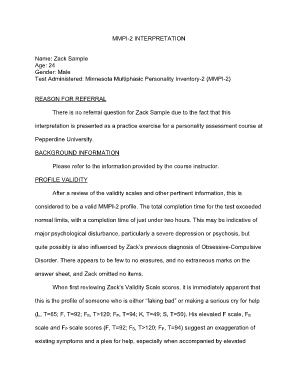

The MCS diagnosis is still rejected by many doctors in part because it is difficult to quantify objectively-but then, so are headaches. The illness you probably need to know the most about is MCS, both because it is common among chemical injury patients, and because doctors often don’t recognize it in their patients.
#Mmpi 2 trial#
Copyright: The Association of Trial Lawyers of America. Reprinted with permission of TRIAL (March 2006). Other symptoms that could be caused by chemical injury include multi-organ system malfunction lower or upper respiratory problems, such as chronic sinus problems multiple chemical sensitivity (MCS) liver or kidney problems and fibromyalgia or other pain disorders.Īlong with nervous system dysfunction, the temporal association of any of these conditions with toxic chemical exposure tends to support the theory that the overall cause of the client’s injuries is a toxic insult to the body.ġFrom: Raymond Singer & Dana Darby Johnson, Recognizing Neurotoxicity, TRIAL, Mar. Symptoms of neurotoxicity include memory and concentration problems confusion multiple sclerosis or MS-type symptoms impaired control of the limbs, bladder, or bowels headaches or migraines sleep disorders, including sleep apnea eye problems that are neurological in origin balance and hearing problems muscle weakness anxiety or panic attacks depression and other psychiatric or neurological symptoms. What do chronic pain, anxiety, neurological problems, confusion, psychiatric symptoms, and cognitive declines have in common? They can all result from neurotoxic chemical exposure. 4 PET and SPECT (single photon emission computed tomography) scans offer a more dynamic look at brain structure, but both of these tests still need interpretation as to the cause of the abnormality (which could be benign). Positron emission tomography (PET) scans, however, corroborated the impaired function. In one study of six head-injury cases, CT and/or MRI scans yielded little or no evidence of neuropathology as detected by neuropsychological testing. Neuropsychological testing tends to be more sensitive to brain injury than CT and routine MRI scans, which provide only a static and relatively gross view of neural structure. 2 In our and others’ experience, imaging techniques can occasionally pick up abnormalities caused by neurotoxicity and may be helpful for forensic purposes, but they are not cost-beneficial for routine screening. Researchers have noted that imaging techniques are often of little value in evaluating neurotoxicity. (This is true for head-injury patients and those suffering from dementia, as well as those affected by exposure to toxic chemicals.) The most reliable and widely accepted way to assess actual brain function is through neuropsychological evaluation. A person’s ability to think, perceive, control emotions, plan, and manage his or her life can diminish drastically without anything being visible to a radiologist or neurologist on an MRI or a CT scan. Neurotoxicity can be documented, but perhaps not in the way you might think. This is important for a lawyer to know, because doctors often recognize only the person’s physical illness, not realizing that serious brain and nervous system damage may have also occurred. The symptoms may seem vague and unconnected, leading you to wonder, “Could these symptoms really be caused by a chemical exposure?” Once you recognize the signs and understand them in context-as a constellation of symptoms resulting from a toxic injury-you will have greater confidence in bringing your client’s case to justice.Ī person who has suffered a serious chemical injury is likely to have sustained considerable damage to his or her brain and nervous system. Chemically injured clients often report a confusing array of symptoms, with no medical diagnosis. Neurotoxicity-poisoning of the brain and nervous system-is a well-documented effect of exposure to many widely used chemicals, yet doctors (and lawyers) often fail to recognize it.

But there are ways you and your experts can pinpoint the damage and its cause.
:max_bytes(150000):strip_icc()/168307664-56a795b33df78cf772976163.jpg)
The symptoms of brain injury from exposure to hazards like lead paint and toxic chemicals vary widely.


 0 kommentar(er)
0 kommentar(er)
